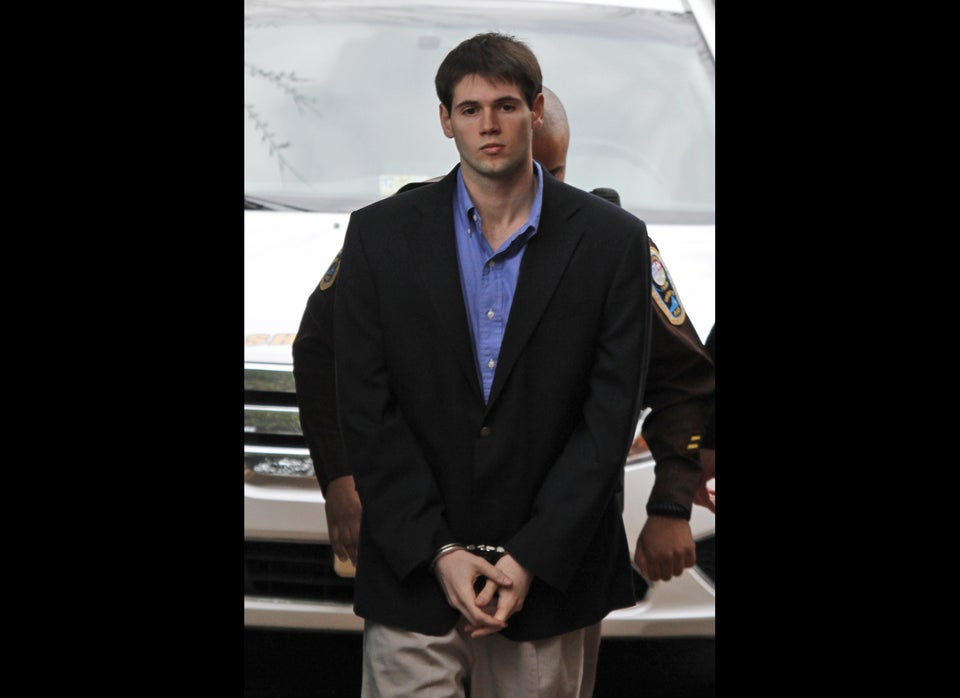
CHARLOTTESVILLE, Va. -- Before a jury of George Huguely V's peers convicted him in February of killing his ex-girlfriend Yeardley Love, members saw footage of his hysteria during an interrogation by police, photos of Love's bloodstained bedroom and a series of plaintive text message he wrote to her. Today, for the first time, the same evidence was revealed to the public.
The jury recommended a 26-year sentence after finding Huguely guilty of second-degree murder for the May 2010 beating death of Love, a senior and fellow University of Virginia lacrosse player. He is currently imprisoned awaiting official sentencing in August, when a judge will either put him behind bars for the full 26 years -- which includes a recommended one year for stealing Love's laptop -- or reduce his term.
Tuesday's public viewing in Charlottesville Circuit Court, however, was the first opportunity for non-jurors to see him during the 64-minute video, in which he was informed of Love's death. It was also the first chance for the media to see photos, text messages and other evidence originally displayed only to the jury and attorneys.
Footage from the police interrogation was perhaps the most anticipated piece of evidence. It begins with Huguely alone in a narrow room seated at the end of a wooden desk, wearing a black T-shirt and shorts while waiting for Charlottesville detectives.
At trial, the public could hear, but not see the taped interrogation. Some of the statements Huguely made had already been circulated by the media, such as his admission that "maybe I shook her a little bit" and "I may have grabbed her by the neck."
The questioning begins with police asking him to describe what happened the night before when Love died.
He's animated throughout his retelling of the argument and fight in Love's bedroom. He raises his hands to demonstrate shaking her by the shoulders and mimics the way he said she knocked her head against a wall. He clenches his fist to reenact reaching through a hole he'd kicked in her bedroom door to unlock it.
At other times, he sits with his arms crossed as he repeats answers, often brushing back his shaggy hair, which was more neatly cropped during the trial.
Early in the questioning, Huguely insists that he "never struck her or hit her in the face," a claim he frequently repeated.
More than halfway through the video, a detective informs Huguely that Love is dead. After several seconds of silence, Huguely is transformed. "She's dead," he says, looking downward. "She's dead," now holding his head.
Seemingly in disbelief, he repeats the words several times before denying again that he hit her. "She's not dead. She's not dead," Huguely says, sobbing at times. "I didn't hurt her...I don't believe it."
"Kill me," he says, leaning his head against the wall as detectives stand him up to handcuff him.
Story continues below
He's returned to his chair for more questioning. Stomping his foot over and over, Huguely says several times, "I told you what happened."
The tape cut off with Huguely resting facedown on the table.
The raw emotion of those moments helped convince the jury that Love's murder was not premeditated.
"You see his change in demeanor when he finds out it's something serious," juror Ian Glomski told The Huffington Post. "When they say 'she's dead', he completely freaks out."
Before going to Love's apartment, Huguely sent a series of text messages to other women, seeking a rendezvous. In a message displayed in court today, Huguely invited one woman to "come ova," but she turned him down, replying that she was at the library.
Glomski, a University of Virginia microbiologist, said Huguely's interest in a late-night tryst also helped prove that he didn't plan to kill Love, as the prosecution claimed.
Photos of Love's body, her medical records and other so-called sensitive pieces of evidence that the jury saw were not made available. A decision about their release is pending, however.
What juries get to see during criminal trials is often different than what's available to the public, William and Mary Law School professor Linda Malone told The Huffington Post.
"It's completely a balancing test that involves the judge's discretion. The jury is making a very critical determination of innocence or guilt," said Malone. "The public has a right to be an informed public, but that's not the same thing."
The crime scene photos contained powerful images. There were multiple pictures of a large blood stain on a yellow-and-white patterned pillowcase that was likely Love's. Others focused on splotches of blood on the comforter, sheets and carpet. The pictures weren't labeled.
Photos showed splintered wood and a gaping hole about 3-inches wide in a bedroom door probably created by Huguely's kick.
Police photographed Huguely standing in flip-flops with his ankle shackled. There were closeups of his bruised and swollen fingers -- injuries that he told police came from playing lacrosse. There were shots of a scratch on his wrist and gash on a leg.
Huguely told police that he went to Love's apartment to reconcile after a recent fight in which he claimed that Love struck him repeatedly in his apartment.
A batch of text messages and emails between them flashed for seconds on a flat-screen television in the courtroom., offering a brief glimpse into their tumultuous relationship that continued on-and-off for more than two years.
"Help me make this work," Huguely wrote in one.
In an email from Love to Huguely, she wrote, "I have never been in a relationship like this and I don't know what to do," according to WINA.
The atmosphere outside the brick courthouse on shady East High Street was calm and quiet compared to the caravan of reporters, television crews and curious court-watchers that followed every movement of Huguely's trial three months ago.
"Today? This was nothing," a court officer said to HuffPost. "We had to use two buildings during the trial."
Besides members of the media, there were few spectators on the wooden benches in the courtroom. Several people declined to comment about why they attended.
Another viewing of the same evidence is scheduled for Wednesday afternoon; photography is not allowed. Media organizations requested that the judge make the material accessible.

